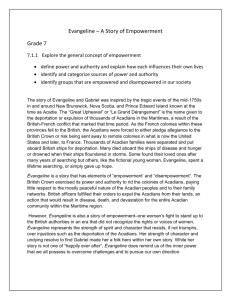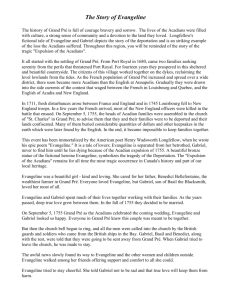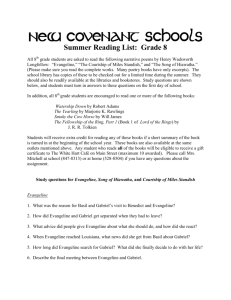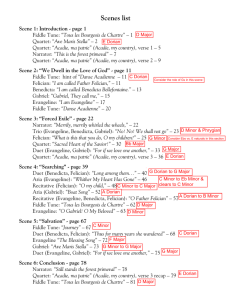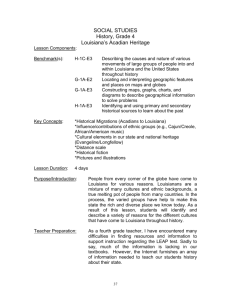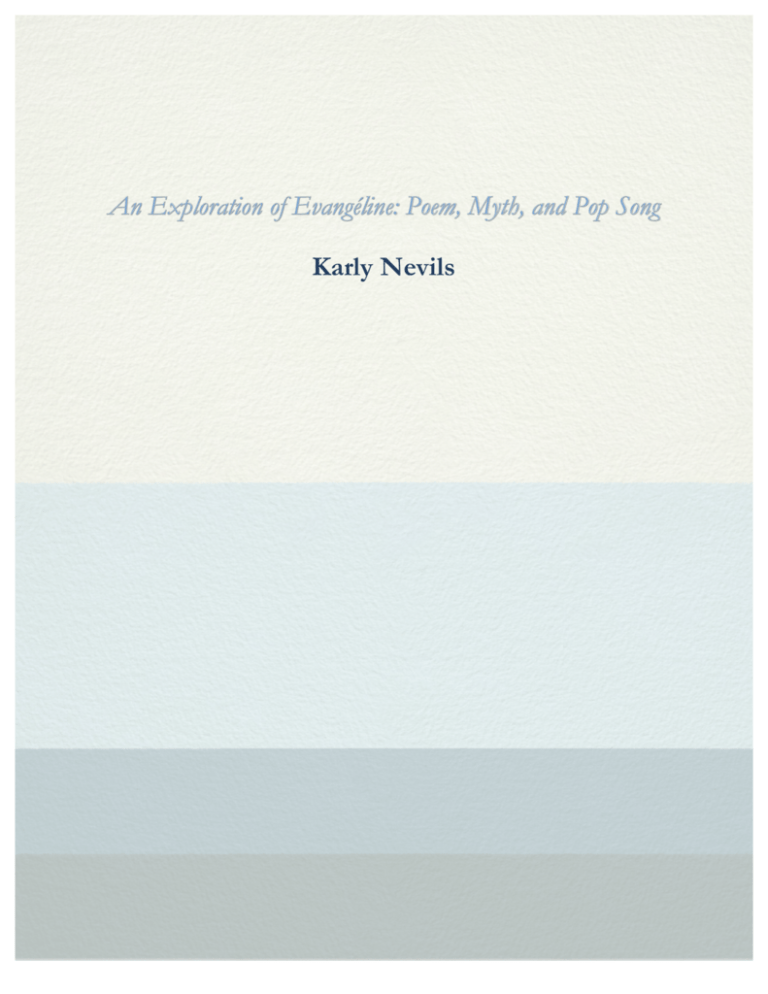
Karly Nevils
AN EXPLORATION OF EVANGÉLINE: POEM, MYTH, AND POP-SONG
CAPSTONE SEMINAR SERIES
Disturbing Representations; Citizenship, Media, and Identities
Volume 5, Number 1, Spring 2015.
Managing Editor
Dr. Anne Trépanier
Desk-top publishing
Ryan Kuhn
Editorial Board
Sara Anderson, Martha Attridge Bufton, Sarah Baker, Dr. Péter Balogh, Greer Brabazon,
Victoria Ellis, Dr. Jerzy Elzanowski, Jessica Helps, Anna Hoque, Cassandra Joyce, Ryan Lux,
Elaine Radman, Sarah Spear, Dr. Anne Trépanier
Revision
Emma Gooch
Copyright Notice
© Karly Nevils, 2015.
All rights reserved. No reproduction, copy, or transmission of this publication, or part thereof in
excess of one paragraph (other than as a PDF file at the discretion of School of Canadian Studies at
Carleton University) may be made without the written permission of the author. To quote this article
refer to: ―, Karly Nevils " An Exploration of Evangéline: Poem, Myth and Pop song", Volume 5, number
1, Spring 2015, page number and date of accession to this website:
http://capstoneseminarseries.wordpress.com
2 KARLY NEVILS
An Exploration of Evangéline: Poem, Myth and Pop Song
ABSTRACT
The Grand Dérangement is the forced exile of the Acadians by the British Crown,
occurring in 1755. Evangeline from Henry Wadsworth Longfellow was published
in 1847. The poem is based on the love story of Evangeline and Gabriel, and is set
during the Grand Dérangement in Grand-Pré. The poem was an instant success in
part due to the popularity of character-based literature at this time. Part of the
appeal of the poem was the themes of Christianity that Longfellow inserted into the
story. This research paper examines how Evangeline migrated from a story to a
myth because of Acadian Elites linking the specific story of Evangeline to the
Acadians' cultural past. Acadian elites were able to transpose their identity in this
story of the Deportation as result of the themes of the Grand Dérangement present
in Evangeline. The manner in which artists have built on Longfellow’s Evangeline
in their musical works is also explored. Each musician has a unique interpretation
of the poem as well as of the Acadian heroine, Evangeline.
KEYWORDS
Grand Dérangement, Acadian, Evangeline, Myth
CAPSTONE SEMINAR SERIES, Disturbing Representations; Citizenship, Media, and
Identities, Volume 5, number 1, Spring 2015.
3 AN EXPLORATION OF EVANGÉLINE: POEM, MYTH, AND POP-SONG
The Acadian World Congress is held every five years, attracting Acadians from around the
world. The seminars and conferences component of the Congress involves discussions of major
themes, which promote an image of modern Acadia. Acadian cultural identity requires constant
examination as it is forever evolving. In the past, Acadians have used myths to differentiate
themselves from Anglophones and other Francophones. The manner in which myth, and in
particular, Evangéline as a myth, has been used up to now can provide context as to how new
myths could help convey the sense of a modern Acadian identity.
The poem Evangeline: A Tale of Acadie was written by Henry Wadsworth Longfellow and
published in 1847. The poem is set during the Grand Dérangement, the forced exile of the
Acadians by the British Crown, occurring in 1755. This poem quickly became widespread and
was read by people worldwide. The story of Evangeline was able to excel in popularity due to
the height of character-based literature at that time. Themes of the poem, such as purity and
innocence, understood within the spectrum of he Catholic religion, enabled it to resonate with
both Acadians and non-Acadians alike. How did Evangeline migrate from a story to a myth?
Acadian Elites cited Evangeline as a replica of the Grand Dérangement and encouraged the
Acadian population to link the fictional story to their cultural past. Indeed, Evangeline has
characteristics that enable it to be assumed as a cultural myth.
Since it was published, Evangeline has inspired the artistic works of various artists. How has
Evangeline influenced the songs of musicians? Each musician has a unique interpretation of the
poem as well as of the role of the Acadian heroine, Evangeline. This paper examines the musical
interpretations of Evangeline by Michael Conte and Angèle Arsenault.
The Grand Dérangement
For the purpose of this paper, Acadians are defined in relation to the territory they inhabited in
the early half of the 1700s. Acadians are the descendants of French settlers who arrived on
Sainte-Croix Island in 1604. They subsequently developed the French colonial territory called
Acadia, which at one time covered the Canadian Maritime provinces, parts of Quebec, and New
England. Despite Acadia being under English rule since 1713, the Acadians refrained from
taking an oath of loyalty to the King. Their choice to remain neutral would lead to their
displacement by the British (1755-1763). British ships took the Acadians to the thirteen colonies
and regions in Britain and France. This relocation of the Acadians is referred to as the Grand
Dérangement.1
The poem Evangeline: A Tale of Acadie was authored by Henry Wadsworth Longfellow and
published in 1847.2 The poem is about the love story of Evangéline and Gabriel, and is set during
the Grand Dérangement in Grand-Pré. On their marriage-day, the inhabitants of Grand-Pré are
notified that the British Crown is seizing their properties and they are being expelled from the
region. Evangeline and Gabriel are placed on two separate rafts, and sent to the thirteen colonies.
In the second section of the poem, Evangéline searches for her fiancé Gabriel for many years but
is unable to find him. After renouncing her search, she settles in Philadelphia and becomes a nun,
dedicating her life to aiding the sick and less privileged people in the city. Infected with small
1
Yoke Araki, “Reading Longfellow’s Evangeline from a Transnational Perspective,” Keiwa College 17, no. 2
(2008): 126-127.
2
Henry Wadsworth Longfellow was one of the founding fathers of American literature.
4 KARLY NEVILS
pox, Gabriel is brought into the hospital where she works. Evangéline recognizes her long-lost
love and takes him into her arms, but Gabriel passes away as she kisses him. This is the final
scene of Longfellow’s poem, but it is the prologue of adaptations of Evangeline that would
spread worldwide.3
The Origins of Evangeline
The time period in which the poem Evangeline was published assisted in its popularity.
Evangeline was published in book format in the 19th century, which was a time when characterbased novels were popular.4 Five thousand copies of Evangeline were sold in the first year, and
one hundred years after its first appearance, 270 editions and 130 translations had been written.5
Its continued success enabled Evangeline to travel across cultural boundaries and resonate with
both Acadians and non-Acadians alike. There are differing opinions about the origin of
Evangeline. It is popular belief that the poem originates in a tale relayed by Reverend Horatio
Lorenzo Connolly, rector of St. Michael’s Episcopal Church in South Boston, to Nathaniel
Hawthorne, an American novelist and short story writer.6 Hawthorne did not wish to use this
story as an influence for his work.7 The story was retold to Longfellow at a dinner party that both
Hawthorne and Connolly attended.8 Longfellow reportedly stated, “It is the best illustration of
faithfulness and the constancy of [a] woman that I have ever heard or read”.9 Hawthorne
permitted Longfellow to use the story. Longfellow’s intention was not to write on the Acadian
Expulsion, but rather the image of Christian virtue.10 In Evangeline’s Quest, Judith Cowan, a
writer and professor of literature, states, “It was a story where he said that he could describe a
woman’s fidelity, her feminine qualities, that courage and endurance that woman may display in
difficult times”.11 Longfellow sought to inject the nature of human dignity into his writings.12
Novels of the Nineteenth Century were centred on the virtuous soul and the manner in which
they could stand out in their surroundings. They depicted individuals that were engaged in their
3
“Symbols of Acadia,” World Acadian Congress, accessed March 25, 2015,
http://www.cma2014.com/en/component/content/article/9-apropos/84-symboles-de-l-acadie.
4
The novel is a fictitious narrative of book length. Longfellow's Evangeline embodies both of these characteristics;
therefore, for the purpose of this paper, the poem is equated to novel.
5
Naomi Griffiths, “Longfellows Evangeline: The Birth and Acceptance of a Legend,” Acadiensis 11, no. 2 (1982):
28.
6
Leigann Neilson, “Marketing the Forest Primeval: The Development of Romantic Tourism in the Land of
Evangeline, 1847-1920,” in Proceedings on the Conference on Historical Analysis and Research in Marketing, 11,
(2003): 4.
7
Ibid, 5
Idem.
9
Greg Gatenby, Canada is Always There. Canada Through the Eyes of Foreign Writers, (Toronto: Vintage Books.
1994), 245.
8
10
Neilson, Supra pp. 5
Idem
12
Ginette Pellerin, Evangeline’s Quest, Web, National Film Board of Canada (1996; First Run/Icarus Films, 1993),
Documentary.
11
CAPSTONE SEMINAR SERIES, Disturbing Representations; Citizenship, Media, and
Identities, Volume 5, number 1, Spring 2015.
5 AN EXPLORATION OF EVANGÉLINE: POEM, MYTH, AND POP-SONG
communities.13 In The Novel in Search of Itself: A Historical Morphology, Thomas Pavel writes,
“Seeking plausible examples of moral strength and beauty, these authors examined the
universe….to discover examples of virtue buried in the foggy past, lost in exotic countries, or
trapped in the labyrinth of modern society”.14 Longfellow implanted these virtues into his
heroine Evangeline.
The Virtues of Evangeline
Evangeline’s persistence to find her fiancé Gabriel is a depiction of ultimate loyalty and love to
another. This intense tale of love is attractive to many readers. The quest for love is a
predominant feature of various artistic works in Western society. This concept resonates with
readers because love is some thing that people seek out in real life. This is the ideal that
Evangeline and other works advertise as the necessary component to a fulfilling life.The name
Evangeline did not exist in the Acadian community prior to the creation of this poem.15
Historian, Maurice Basque, claims that it is likely that the name Evangeline has Christian
origins. Basque states, “It may be derived from Eve, the first woman…along with Evangelical,
meaning good news”16. Evangelicals live in accordance with Christian morality.17 Similarly, the
character Evangeline embodies Christian virtues that other women could aspire to imitate.
Evangeline reflects the Nineteenth Century ideal of the puritan Victorian woman. She is
described in detail as the embodiment of perfection. Villagers viewed her brown hair, black eyes
and porcelain skin as the characteristics of a perfect woman. As an unmarried woman her natural
beauty invoked that of ultimate purity. The poem reads, “Fairer was she when, on Sunday morn,
while the bell from its turret/Sprinkled with holy sounds the air, as the priest with his
hyssop/Sprinkles the congregation, and scatters blessings upon them/Down the long street she
passed, with her chaplet of beads and her missal”.18
This quote depicts Evangeline as a loyal Catholic woman. She is an expression of a saintly
persona living among the Acadian people. “Many a youth, as he knelt in the church and opened
his missal, fixed his eyes upon her, as the saint of his deepest devotion”.19 Christianity was
deeply rooted in society at the time of the creation of Evangeline. The religious themes in
Evangeline faired well with the Acadian population, as they were an astute Catholic group. The
character Evangeline also resonated with non-Acadians who practiced the Catholic faith.20
Acadians and non-Acadians alike were able to relate to Evangeline because it resonated
with the themes of their Christian societies. The character Evangeline is a moral compass that
13
Thomas Pavel, “The Novel in Search of Itself: A Historical Morphology,” in The Novel 2006, ed. Franco Moretti
(New Jersey: Princeton University Press, 2006), 22.
14
Idem. 15
Barbara Leblanc, “Evangeline as an Identity Myth.” Canadian Folklore 15, no. 2 (1993): 140.
16
Pellerin, Supra
Timothy Larsen, The Cambridge Companion to Evangelical Theory (Cambridge: Cambridge University Press,
2007), 261.
17
18
Henry Wadsworth Longfellow, Evangeline: a Tale of Acadie, (Atlantic Canada: Nimbus Publishing, 1991), 3.
19
Idem. Griffiths, Supra pp. 29
20
6 KARLY NEVILS
anyone may aspire to replicate. The Acadians of Grand-Pré bestow on her the status of deity on
earth. In Myth and Meaning, Levi Straus states, “in all American mythology…we have deities or
supernaturals who play the roles of intermediaries between the powers above and humanity
below”.21 Evangeline links the reader to a divine sense of morality that resembles a heavenly
existence. The Christian themes in Evangeline are also present in mythology. The poem’s
characteristics enabled it to be assumed by Acadians as a cultural myth.
The Migration of Evangeline from a Story to a Myth
Acadian elites have used Evangeline as a cultural myth to provide Acadians with a common
history that they could relate to. The term myth holds more than one definition. Daniel Francis
depicts myth as an explanation of the past that enables people to feel engaged in a national
enterprise.22 Myths are able to comfort and inspire people that can connect to them.23 However,
they exclude individuals that do not view themselves as being reflected in the stories.24 These
people can force their way into the story of a nation by creating their own myths.25 A story of a
nation is a collection of myths describing a history of said nation. Acadians have done this using
the poem Evangeline.
In the late Nineteenth Century, Acadian cultural elites were scrutinized for being unable to
differentiate themselves from other cultural groups, specifically French Canadians.26 For
example, a critic for the Montreal newspaper, Le Pays, in 1868 writes, “One cannot grant a
nationality to a people unless they stand for something and unless they have ‘une vie propre, un
caractère distinctif…ensemble d’idées, de moeurs, de faits politiques…de direction vers un but
nettement defini et clair pour tout le monde”.27 At this time, Canadiens28 wished to recognize
Acadians as a subset of their cultural nation.29 Acadian elites used the poem Evangeline to claim
that their cultural identity was rooted in the Expulsion. Evangeline captured the notion of
Acadian identity during the Acadian Renaissance from 1867-1960. This was a time for nation
building and increasing a collective awareness about Acadian identity.30 Prominent Acadian
issues began to be addressed in this period.31 The renaissance enabled Evangeline to become a
prominent Acadian symbol, since at this time Acadian elites were looking for some thing to act
as a marker for their identity.
21
Levi, Strauss, Myth and Meaning, (London: Routledge, 2001), 3.
Daniel Francis, National Dreams, Myth, Memory, and Canadian History, (Vancouver: B.C. Aresenal Pulp, 1997),
172.
23
Ibid
24
Ibid
25
Ibid
26
Araki, Supra pp. 4
22
27
Ibid
Canadiens refers to the population of the Saint-Laurence valley, descendants of New France settlers. At the time
of Confederation, they will slowly becoming to be called French Canadians.
29
Ibid
30
“Yesterday’s Acadia,” World Acadian Congress, accessed 25 March 2015, http://www.cma2014.com/en/apropos-de-nous/l-acadie-d-hier-a-aujourd-hui
31
Ibid
28
CAPSTONE SEMINAR SERIES, Disturbing Representations; Citizenship, Media, and
Identities, Volume 5, number 1, Spring 2015.
7 AN EXPLORATION OF EVANGÉLINE: POEM, MYTH, AND POP-SONG
In Mythography: The Study of Myths and Rituals, William Doty asserts that for a myth to have
vitality it must “[address] itself directly to the need of the culture to have answers concerning
questions and problems of human existence”.32 Acadian elites used the poem to connect the
dispersed Acadian community to common history, which shaped their cultural identity. For
Acadian Nationalists who lacked a historical record of Acadian’s shared experiences to present
as their cultural identity, Evangeline was the perfect text.33 The 1865 French translation of
Evangeline provided Acadians with common text to read and learn about their identity. In
presenting Qu’est-ce qu’une nation? in 1882, French philosopher Ernest Renan depicts myth as
being able to assist a nation in constituting an identity. Myth is depicted as the binding
characteristic of a nation, which aids in its continued existence. Renan defines myth as, “a shared
memory of a common history of…sacrifices, common suffering…that affectively motivates the
present will to bind together, to act in a unified fashion”.34 This definition corresponds to how
Acadian elites used Evangeline to connect Acadians to a shared identity associated with their
deportation. This inspires Acadians to ensure that their identity remains firm despite their
dispersion.
A myth can be better interpreted by examining the manner in which persists in existing
societies.35 Strauss articulates, “myths of a given population can only be interpreted and
understood in the framework of the culture of that given population”.36 The myth of Evangeline
can be understood in the way it has been used as an instrument of identity. Acadians view the
events in Evangeline as a historical replica of the Grand Deportation and relate it to their cultural
past. Despite the fact that aspects of the poem could be based on some truths, the poem still
remains a fictional story. In Myth, Steblin-Kamenskij states, “myth is a narrative that is held to
be true by those who create and preserve it, no matter how untrue to reality it may seem”.37
Those that create and preserve myths view them as being real; thus, these people also consider
the characters and events in it to be real. What may originate as an artistic creation can evolve
into a myth presumed to be founded on historical fact the more it is told. Despite emerging as a
fictitious character, Evangeline has achieved the status of a real person.
The Migration of Evangeline in Music
Many artists have sought to build on this Acadian myth since it was published. These artists have
been able to breath new life to the story of Evangeline. This is evident when examining musical
interpretations of Evangeline.
32
William G Doty, Mythography: The Study of Myths and Rituals, (Westport: Greenwood Press. 2004), 50.
Ibid
34
Arash Abizadeh, “Historical Truth, National Myths and Liberal Democracy: On the Coherenceof Liberal
Nationalism,” The Journal of Political Philosohy 12, no. 3 (2004): 292.
33
35
Strauss, Supra pp. 22
Ibid
37
Steblin-Kamenskij. Myth. (U.S.A.: Karmora Publishers, Inc, 1982), 21.
36
8 KARLY NEVILS
Music has historically played a significant role in Acadian communities. Music was an important
part of religious functions, social gatherings, and family entertainment.38 In her essay Acadian
Folk Songs, Elizabeth Brandon writes, “It was sung not only for pleasure but it accompanied the
daily chores of the people. Singing was an especially popular form of entertainment during their
veillées, social gatherings of family, friends and neighbours”.39 Currently, Acadian music has
moved beyond the personal sphere and occupies its own genre in the eyes of the media.40 NonAcadians are also able to hear this music since it is able to travel across boundaries because of
new media and technology. Various songs explore Acadian themes, such as the deportation, or
Evangeline.
Evangeline has inspired numerous artistic works such as plays, movies, opera’s, and popular
songs. This illustrates that the myth of Evangeline has continued to inspire Acadians and nonAcadians alike to build not only on the narrative but also on the myth itself. This section of the
paper focuses on portrayals of Evangeline in music. This medium has been selected because of
the ease of accessibility of music across diverse boundaries, such as language or culture. Artists
who have used the myth of Evangeline as a basis for their music have had varying interpretations
not only of the poem but also of the character. The manner in which the heroine is presented in
music can alter the public’s perception of said character. A listener’s perception could be more
easily influenced if they have not read Evangeline and are relying solely music to gain insight
into the heroine.
In 1971, Michel Conte wrote the song “Evangeline”. Numerous artists have performed this
song, including Quebecois singer Isabelle Pierre. Conte does not deviate from Longfellow’s
portrayal of Evangeline; the song is simply a retelling the poem. After hearing it, people can
understand the basic plot line of Evangeline.41 The final stanza highlights the survival of
Evangeline and the Acadian people despite the deportation. The song reads, “Il existe encore
aujourd’hui/Des gens qui vivent dans ton pays/Et qui de ton nom se souviennent”.42 Conte
recognizes the continued existence of an Acadian nation. However, it is difficult to mark on a
map the location of this nation, since Acadians are dispersed across different territories due to the
deportation.
38
Brooke Bisson, “Acadian Music as a Cultural Symbol and Unifying Factor,” (master’s thesis, Saint Mary’s
University, 2003), 5.
39
Ibid
40
Ibid
Ibid 113
42
Michael Conte Lyrics. Évangeline. 1971. https://memoirechante.wordpress.com/2011/12/29/michel-conteevangeline/
41
CAPSTONE SEMINAR SERIES, Disturbing Representations; Citizenship, Media, and
Identities, Volume 5, number 1, Spring 2015.
9 AN EXPLORATION OF EVANGÉLINE: POEM, MYTH, AND POP-SONG
The myth of Evangeline has bypassed borders and resonates with people worldwide. The song
states, “Ton nom c’est plus que l’Acadie/Plus que l’espoir d’une patrie/Ton nom c’est le nom de
tous ceux/Qui malgré qu’ils soient malheureux/ Croient en l’amour et qui espèrent.43 The myth
acts as a link that connects people to the cultural history of Acadians and the deportation.
Acadians as well as non-Acadians can connect to the underlying themes of Evangeline,
specifically the subjects of love and hope. These prominent themes are also present in many of
the books, movies and plays that society is exposed to and seeks to experience.
Angèle Arsenault’s “Evangeline Acadian Queen” was released in October 1977. Arsenault’s
song presents Evangeline in a way that is distinct from Conte. The song focuses on the
commercialization of Evangeline and the way that she has evolved from a fictitious character to
a pop cultural icon.44 In the second last stanza, Evangeline declares that she will popularize her
name by investing in future enterprises. The lyrics read, “Je m’en vais pour investir/Dans les
compagnies de l’avenir/Afin que l’nom d’Evangeline/Soit connu en câline/Évangeline Fried
Clams/Évangeline Salon Bar/Évangeline Sexy Ladies Wear/ Évangeline Comfortable Running
Shoes”.45 This song depicts how the likeness of Evangeline has been used for advertising. For
example, the Annapolis Valley Cider Corporation Limited offered for sale Evangeline Dry
Ginger Ale. This misappropriation of Evangeline is in contrast to Longfellow’s original concept.
Each of these songs takes a different approach on Evangeline. The striking differences of the
songs demonstrate that once some thing hits critical mass its interpretation is left open to the eyes
of the reader. Myths by their very nature are open to multiple interpretations, which can give the
original myth new meaning. Since the reader experiences the poem through their own lens, they
bring with it their own understanding, which can influence others interpretations through
retellings of the myth.
Re-evaluating Evangeline
This essay has discussed how Evangeline is a cultural myth that portrays Acadian identity. A
century after the peak of its success however, since the late 1960s, many Acadians have begun to
feel that “she symbolizes a silent and resigned Acadie and would prefer more authentic
symbols”.46 In the book L’Acadie du Discours, Jean Paul Hautcour examines the period of the
1960s and 70s, when Acadian intellectuals began to question the advantage of symbols such as
Evangeline for current Acadian culture.47 Various contemporary Acadian writers have rejected
the Evangeline myth, and have replaced the character Evangeline with alternative cultural
heroes.48 For example, in Evangéline Deusse, Antonine Maillet unveils a depiction of Evangeline
that is a Twentieth Century Acadian woman living in exile in Montreal. However, it is
43
Idem.
Bisson Supra pp. 117
45
Angèle Arsenault Lyrics. Evangeline Acadian Queen. 1977. http://www.paroles-musique.com/parolesAngele_Arsenault-Evangeline_Acadian_Queen-lyrics,p52327
44
46
Ronald E McFarland. The Long Life of Evangeline a History of the Longfellow Poem in Print, in Adaptation and
in Popular Culture, (Jefferson: N.C, 2010), 69.
47
48
Ibid
Ibid
10 KARLY NEVILS
questionable if this is a rejection of the myth of Evangeline or whether it simply builds on the
existing myth.
The Tale of Evangéline is not merely a time honoured literary piece that is enjoyed by readers. It
is a part of the cultural heritage of the Acadian people, which provides useful insight into the
heart and minds of the Acadians during one of the worst experiences in their history. Evangeline
has migrated from a story to a myth due to the work of Acadian elites. The myth of Evangeline
has become so identifiable that it has been considered a historical event rather than a work of
fiction. Recently, Acadians have rejected the myth of Evangeline as a cultural symbol because
they do not believe that it embodies the characteristics of their modern identity.
If Acadians reject the Evangeline myth will a new one be created? Can Acadians be united in a
cultural identity without the existence of myth? These are questions that will require additional
research on this topic. The representation of Acadian identity in contemporary society must be
further addressed. The Acadian World Congress revaluates Acadian identity every five years
because it is constantly shifting.
Works cited
Abizadeh, Arash. “Historical Truth, National Myths and Liberal Democracy: On the Coherence
of Liberal Nationalism.” The Journal of Political Philosohy 12, no. 3 (2004): 291-313.
Araki, Yoke, “Reading Longfellow’s Evangeline from a Transnational Perspective,” Keiwa
College 17, no. 2 (2008): 125-141.
Arsenault, Angelè. Evangeline Acadian Queen. Libre, 1977. http://www.parolesmusique.com/paroles-Angele_Arsenault-Evangeline_Acadian_Queen-lyrics,p52327
Brooke Bisson, “Acadian Music as a Cultural Symbol and Unifying Factor,” (master’s thesis,
Saint Mary’s University, 2003.
Conte, Michael. Évangeline. 1971. https://memoirechante.wordpress.com/2011/12/29/michelconte-evangeline/
Doty, William G. Mthography: The Study of Myths and Rituals. Westport: Greenwood Press,
2004.
Francis, Daniel. National Dreams, Myth, Memory, and Canadian History Vancouver: B.C.
Aresenal Pulp, 1997, 172.
Gatenby, Greg. Canada is Always There. Canada Through the Eyes of Foreign Writers Toronto:
Vintage Books, 1994.
Griffiths, Naomi. “Longfellows Evangeline: The Birth and Acceptance of a Legend,” Acadiensis
11, no. 2 (1982): 28-41.
CAPSTONE SEMINAR SERIES, Disturbing Representations; Citizenship, Media, and
Identities, Volume 5, number 1, Spring 2015.
11 AN EXPLORATION OF EVANGÉLINE: POEM, MYTH, AND POP-SONG
Larsen, Timothy. The Cambridge Companion to Evangelical Theory. Cambridge: Cambridge
University Press, 2007.
Neilson, Leigann, “Marketing the Forest Primeval: The Development of Romantic Tourism in
the Land of Evangeline, 1847-1920,” in Proceedings on the
Conference on Historical Analysis and Research in Marketing, 11, (2003): 1-12.
Pavel, Thomas. “The Novel in Search of Itself: A Historical Morphology.” in The Novel, ed.
Franco Moretti, 3-32. New Jersey: Princeton University Press, 2006.
Pellerin, Ginette. Evangeline’s Quest. Web. National Film Board of Canada. 1996. First
Run/Icarus Films; 1993. Documentary.
Ronald E McFarland. The Long Life of Evangeline a History of the Longfellow Poem in Print, in
Adaptation and in Popular Culture, Jefferson: N.C, 2010.
Steblin-Kamenskij. Myth. U.S.A.: Karmora Publishers, Inc, 1982.
Strauss, Levi. Myth and Meaning. London: Routledge, 2001.
“Symbols of Acadia,” World Acadian Congress. Accessed March 25, 2015.
http://www.cma2014.com/en/component/content/article/9-apropos/84-symboles-de-l-acadie.
“Yesterday’s Acadia,” World Acadian Congress, Accessed 25
http://www.cma2014.com/en/a-propos-de-nous/l-acadie-d-hier-a-aujourd-hui
March
2015,
12

